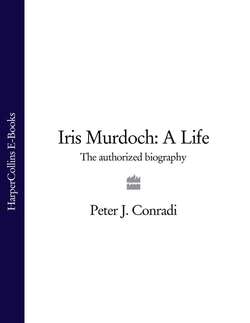Читать книгу Iris Murdoch: A Life: The Authorized Biography - Peter Conradi J. - Страница 15
7
ОглавлениеThe nineteenth century saw a downturn in Richardson fortunes, with the sons of yet another Alexander Richardson (1758–1827) squandering part of the £8,000 realised from sale of the Farlough estate. The phenomenon of downstart Anglo-Irish gentry was so familiar as to earn its own ingenious characterisation. Sir Jonah Barrington, whose racy memories of Irish history both Yeats and Joyce plundered, defines as ‘half-mounted gentlemen’ the small grantees of Queen Elizabeth or Cromwell living off two hundred acres. The Richardsons had been grander, somewhere between ‘gentlemen every inch of them’, whose finances were ‘not in good order’, and ‘gentlemen to the backbone’, from the oldest settler-families, generally also ‘a little out at elbows’.41 Most of Iris’s immediate maternal forebears were minor men-of-law – Dublin was a litigious city with many attorneys – belonging to the Protestant Irish lower-middle class. Rene’s paternal grandfather Robert Cooper Richardson, grandson to Tyrone’s High Sheriff,
born in 1827, and son of Robert Lindesay Richardson, a revenue officer, was a clerk in the Dublin Probate Court. Robert Cooper’s son by his first wife Hannah, Effingham Lynch Richardson, a ‘law assistant’ born in 1857, after a first marriage without issue made a second to Elizabeth Jane Nolan, daughter of William Nolan Esquire.42 Effingham and Jane had two daughters, Gertrude Anna (born 1891)43 and Irene Alice (born 29 March 1899), mother-to-be of Iris.
Rene’s father Effingham Lynch Richardson died on 6 July 1904, not long after Ulysses’ ‘Bloomsday’, one tradition making his death, officially from ‘erphelsocora of the groin’, drink-related.44 The fact that the Rev. A.W. Barton, Rector of St George’s, rather than one of his three curates, took the funeral service, suggests that the family were actively involved in the life of the Church of Ireland at parish level. Iris also claimed – on no evidence – Catholic ancestors.45 Curiously, a second Effingham L. Richardson was shown living at 40 Iona Road, Glasnevin, Dublin, until 1947, and working until 1934 at the Dublin Ministry of Labour. This second E.L. Richardson, a first cousin of the first, was re-baptised as a Catholic before marrying in 1883.46 Rene and her elder sister Gertie took ‘Cooper’, not among the baptismal names of either, as their middle name; they lived thereafter in the house of their grandfather Robert Cooper Richardson, and the twice-adopted name suggests gratitude to him for his generosity in fostering them after their father’s death. The only story Rene would tell of her grandfather was that, though a man of industrious habits who at first kept his family well, when the 6 p.m. mail van arrived he would be facetious about this, in his Dublin manner. It was a signal for his first drink of the evening.
From 1906 the girls lived with their grandfather at 59 Blessington Street, a ‘wide, sad, dirty street’, Iris wrote, with ‘its own quiet air of dereliction, a street leading nowhere, always full of idling dogs and open doorways’.47 It runs parallel to Leopold Bloom’s Eccles Street close by, and is halfway between St Joseph’s Carmelite Church and the Anglican ‘Black’ Church, at the heart of that cheerless north inner city to which the Joyces retreated across the Liffey, with all their baggage in two large yellow caravans,
when their fortunes took a downturn. Within a twilit world there are degrees of gloom and seediness. It is not hard to see why the 1906 move that Rene’s grandfather made, away from the address given as 34 ‘Upper’ Rutland Street,48 where Rene and Gertie were growing up, was propitious. A street of ill-repute, Joyce placed Nighttown and its brothels at the end of it at that time.
The northern inner city49 had been defeated first by the Duke of Leinster choosing in the 1740s to build on the South Side —'Where I build, Fashion will follow’ – and next by the exodus of gentry to England from around Luke Gardiner’s Mountjoy Square after the 1801 Act of Union. But, above all, by the massive immigration into the area of starving country people during and after the Famine, resulting in the division of whole terraces into tenements. In their novel The Real Charlotte Somerville and Ross’s down-at-heel, petit-bourgeois, essentially vulgar Protestant heroine Francie lives, in 1895, around Mountjoy Square, very near Blessington Street — like the Richardsons.50 Today number 59 is divided into seven flats, the ground floor having been around 1990 a betting-shop.
